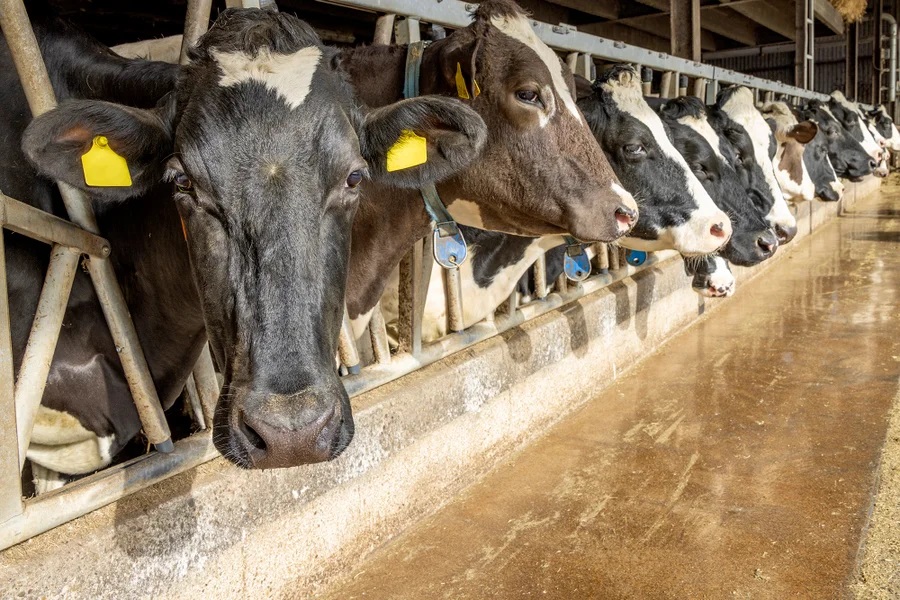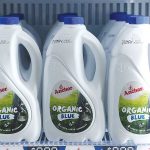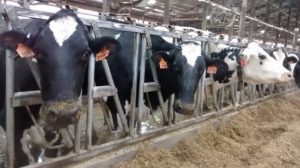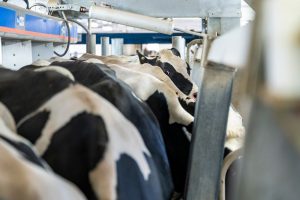
This is an opinion and analysis article, and the views expressed by the author or authors are not necessarily those of Scientific American.
H5N1 is running rampant through dairy cows, putting humans at risk of an epidemic.
A mystery disease was ripping through the cattle in the Texas panhandle.
In early March, roughly three weeks after veterinarians in the panhandle spoke about the first illnesses, one of us (Russo) texted a couple of veterinary colleagues in the thick of the outbreak a recent publication on how H5N1 bird flu was killing unusual numbers of sea lions throughout South America. The dairy cow symptoms sounded like influenza to me. One of those colleagues quickly replied.
Over the next few days, he and I texted back and forth in a flurry about whether the mystery cow disease might be highly pathogenic avian influenza (HPAI), more widely known as bird flu. When I asked about wild birds, this veterinarian noted that there were “a ton of dead pigeons” around the cattle pens and that now he was starting to second-guess his initial suspicion of poison as the cause.
I told him to get the cows tested for HPAI, even if the lab laughed at him. As a dairy-poultry veterinarian, I also asked for pictures of the insides of some of the pigeons, trying to determine if I could observe the lesions characteristic of this kind of avian influenza.
His last message to me that evening hung like a thick fog in my mind over the next several days.
“I really hope this is all wrong because we have some pretty serious human exposure issues going on the cow side of this. How unbelievably unprepared would they be for 500,000 dairy cows with HPAI?,” he asked, referring to the dairy industry.
They were extremely unprepared.
The subtype of bird flu that is going around is more accurately called H5N1, and the current outbreak in dairy cows has escalated to an alarming level. The H5N1 virus is now infecting humans, with many field reports of human illness on dairy farms and three documented cases in people, including one with respiratory symptoms.
Respiratory signs raise red flags: if the virus can be spread through coughing, this would be a significant step toward human-to-human spread. Yet, despite the Centers for Disease Control and Prevention’s best efforts, local health departments, urgent care facilities and emergency rooms still do not recognize H5N1 as now representing a human pathogen in the U.S.
As a group of veterinarians with experience in both the poultry and dairy industries, coupled with expertise in both poultry and human outbreaks and influenza viruses, we believe the dairy industry and regulatory agencies need to move quickly to stop H5N1 from seeding a human epidemic.
With the virus crossing species barriers, the specter of human exposure and emergence of a human-adapted strain is rapidly intensifying. This outbreak in dairy cows has the potential to spiral into a human epidemic or even a catastrophic pandemic—the signals of which we may already be seeing.
To prevent this next catastrophe, dairy producers must step forward to encourage the testing of dairy workers. They must increase testing in dairy cows and federal agencies need to report those results to allow us to track how many people and animals (including the cats, dogs and wild birds on farms) have contracted H5N1.
There are many anecdotal reports of dairy workers feeling “hungover,” or having more pronounced flulike symptoms. But because symptoms have been generally mild, many people have minimized them and continued to go to work. Vigilant testing is critical to track any changes in the virus that may make it spread more easily among humans.
At this point, the dairy industry must put aside cultural and operational differences and start the kind of broad-scale influenza testing and reporting that occurs in the poultry and swine industries. By taking these proactive measures, dairy operators can reduce the risk and impact of H5N1 on their herds and prevent the development of a human-adapted strain of bird flu. We cannot afford to be complacent in the face of this threat, especially after the lessons learned from the COVID pandemic. No one wants to go back to that.
Agriculture in our country primarily focuses on productivity, optimizing the food output relative to input. With this, dairy farm sizes are increasing and becoming more specialized. The H5N1 virus has rapidly infiltrated the dairy industry, spreading to 11 states within a mere four months.
This spread has been partly caused by evolving dairy industry practices, such as co-raising young animals from multiple farms at specialized sites in one part of the country and then transporting them back to their “home” farm for milk production. This practice makes quick, efficient spreading of disease between herds possible. The movement of lactating cows between states is also routine because of the sale of dairy animals, shipping between sister operations and to slaughterhouses.These events all create other opportunities for disease spread.
Dairy cattle, young and old, are inspected by veterinarians before moving across state lines. But it’s possible to certify infected calves, heifers and cows as “healthy” during the virus’s incubation period (when the pathogen is multiplying in the animal but before that animal becomes overtly sick), especially in the absence of testing requirements for within-state cattle movement and non-lactating animals.
Once H5N1 was officially diagnosed in dairy cattle, state and federal agencies were slow to respond, partly because of conflicting priorities—the need to quell consumer concerns and to manage the industry’s desire to continue with business as usual. Regulators eventually did produce a patchwork of policies in a federal order but did not engage with industry during the development process. This resulted in policies that did not consider the long-term economic, animal welfare and health and food security effects of a potential epidemic, not to mention a pandemic.
This “business as usual” approach now includes the unintended and devastating effects on other food systems. Turkey and egg-laying farms are in peril, as bovine flu, which is caused by a specific strain of H5N1 called B3.13, has infected these birds at alarming rates. We have lost more than 13 million laying hens in the U.S. in the past two months. And if we do not control this virus, it will soon be too difficult or expensive to produce eggs or raise turkeys.
Because there isn’t a federal requirement for dairy farms to test their herds outside interstate movements of milking cows and many dairy producers are choosing not to test regardless of proximity to at-risk poultry populations. This leaves many poultry farms as “sitting ducks,” not knowing their infection risk and unsure how to mitigate this new threat—a threat that requires the depopulation of the entire poultry farm were their birds to become infected with H5N1.
This is seen clearly in states such as Minnesota and Iowa, which, until very recently, were considered “negative” for H5N1 in dairy by state and federal regulators. In contrast, wastewater in dairy counties tested positive for H5N1, and increasing numbers of neighboring commercial poultry flocks tested positive for B3.13. The dairy industry must be a better neighbor and steward of human and animal health. This lack of reporting in multiple states also means we do not have access to vital viral information that is important to tracking mutations that could be relevant to human health risk.
The industry needs to consider worker safety as well. The most imminent danger of H5N1 infections to public health is in dairy workers who handle cows and calves daily through milking, feeding, and treating and handling sick cows. Every time workers interact with cows on affected farms, they risk infection, especially if they are not wearing appropriate personal protective equipment (eyewear, mask and gloves, at the very least).
Other at-risk people include those who consume unpasteurized dairy products and pet owners whose dogs or cats may be exposed to H5N1 through locally infected dairy farms or wild animals. This is a numbers game, and these viral “touchpoints” significantly expand the likelihood that the rapidly mutating H5N1 finds a happy host in humans.
Reaching farm workers has been hard. These workers are often undocumented and want to avoid negative attention that may cost them pay or perhaps their entire job. In the meantime, While H5N1 tests for humans are not widely available yet, we are aware of health care workers denying H5N1 diagnostic tests for people who asked for them, even individuals with a history of exposure to sick livestock and a positive influenza A test, which should be major red flags for further H5N1 diagnostic workup.
Many dairy operators have inherent trust issues with local, state and national regulatory agencies, mainly concerning perceived overstepping of authority, leading them not to report H5N1 cases. The few who have reported positive cases have been overwhelmed by the number of regulatory agencies requesting access to their operations, which further deters others.
In response, the U.S. Department of Agriculture rolled out the Voluntary H5N1 Dairy Herd Status Pilot Program and announced an additional $824 million in emergency funds to bolster the testing effort by incentivizing farmers to report cases by indemnifying the loss of milk production that occurs in infected dairy herds.
As fierce individualism comes into play here, many dairy producers ask, What strings will be attached to reporting, and how will this affect my daily operation? As we saw during the COVID pandemic, such thinking can counter public health measures, which could make the H5N1 situation worse in the long term for people and animals.
Even if there was a surge in testing, the problem would not be resolved because we are also facing substantial challenges in accessing the testing results in a timely manner. The federal government requires that all animal testing for H5N1 must happen within a network of diagnostic labs that work with the USDA, which means they also control the sharing of the results.
Historically, the USDA has promptly shared descriptive and sequence data with the scientific community during outbreaks to facilitate learning for all impacted individuals. During this outbreak, we have been aware of delays in disseminating viral sample location and date by at least 30 days in the name of producer privacy.
The scientific community must have real-time access to the general (not specific) location and time data to track how H5N1 is spreading and changing. This information sharing is integral to assessing risk and driving relevant control tactics relative to animal movement and, most importantly, public health.
H5N1 has taken off much faster than we, as a country, could mobilize. It is vital not to dwell on these missteps but rather to work with industry veterinarians and human and animal health regulatory agencies to devise transparent policies and practices to control this disease.
The bigger picture of this issue related to human health has been repeatedly brushed aside in the past few months This is a genuine “One Health” initiative, an opportunity for both animal and human health advocates to work together for the betterment of all species. Set politics aside. Focus on a sustainable, science-driven solution. Act now before it is too late.
This is an opinion and analysis article, and the views expressed by the author or authors are not necessarily those of Scientific American.
You can now read the most important #news on #eDairyNews #Whatsapp channels!!!
🇺🇸 eDairy News INGLÊS: https://whatsapp.com/channel/0029VaKsjzGDTkJyIN6hcP1K

























